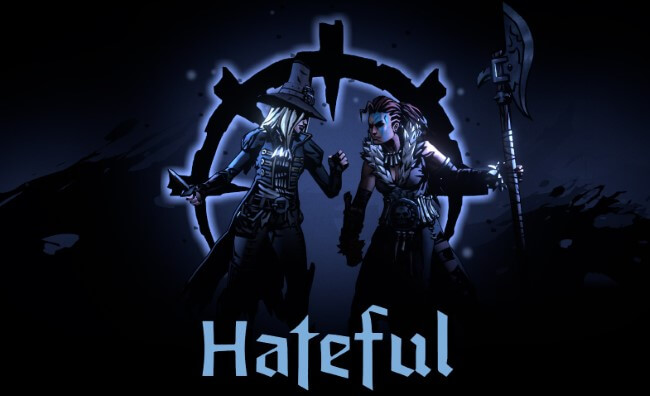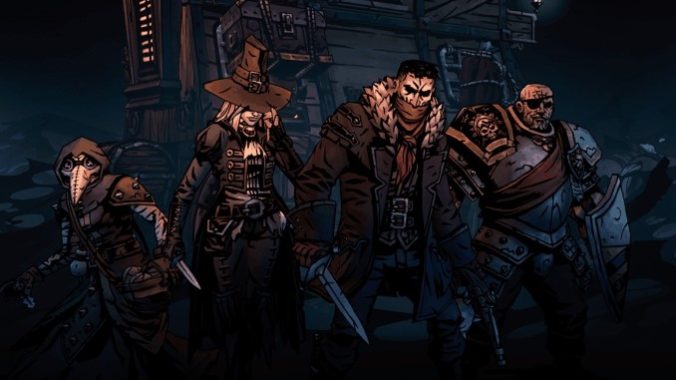Videogame sequels are a delicate proposition, not just for the studios making them but for players forced to confront the sometimes unreasonable natures of our own expectations. For studios, they must answer the question of whether “more of the same” is an acceptable philosophy in a sequel, and if “the fans want more!” is justification for doing so, weighed against the potential creative desire to blow up the original formula and embark into new territory. For fans, we have to consider whether our own desires for what we’d like to see in a sequel truly match up to what best serves the game, whether or not that game is part of a burgeoning franchise. Sometimes, delivering the best sequel simply means defying what many fans are probably expecting. And it feels like this is the case in Red Hook Studios’ Darkest Dungeon II, released in May after a long period in early access.
This is a game that truly could have played things safe conceptually, and I expect fans of the original entry first released in 2016 would have been just fine with that. That game saw the player assembling parties of four adventurers to go on a nigh-endless series of missions in a corrupted hamlet, venturing into different zones in an attempt to survive punishingly difficult waves of enemies and bosses in a grimdark horror setting highly inspired by the likes of H.P. Lovecraft’s cosmic horror stories. A Darkest Dungeon campaign is a true endurance run (especially with the Crimson Court expansion), easily capable of stretching on for 100 hours of gameplay or more as the player upgrades the myriad buildings of the hamlet, levels up their heroes, and then tries (and repeatedly fails) to take down the seemingly unkillable Heart of Darkness. Its turn-based combat is fairly easy to learn, though given depth by the ever-evolving array of quirks and mental handicaps possessed by the heroes as their sanity crumbles in the face of impossible odds. The player’s job is to prop up those frail heroes between each expedition, keeping them just healthy and sane enough to get the job done.
A sequel, then, could have just kept the same exact structure intact: A new setting, perhaps, and a new hamlet, with the same types of adventurers headed out on expeditions to impede some new evil. But that’s not really what Red Hook Studios ended up doing–though they kept the same style of combat and characters, they genuinely overhauled the basic structure of Darkest Dungeon II’s campaign, while layering in new mechanics that end up forming a much deeper social dynamic between its characters. Whereas a mod for the original such as the effective Black Reliquary genuinely offers more of the same for players who want it, Darkest Dungeon II chooses a genuine divergence from effective formula. And to be honest, I wasn’t sure I appreciated those choices at first.
The most immediate, obvious change is that the hamlet is gone–now you have no central location to be slowly upgraded with permanent buffs and boons throughout dozens of hours of play time. Your home base is now instead a rolling carriage housing your heroes as you make individual journey after journey toward the imposing mountain in the distance, where various bosses await. Each journey takes perhaps two hours or more of game time (if you make it there), at which point you’re effectively starting over again with another quartet of heroes, albeit having likely unlocked a few small buffs for next time.
The effect here is to make Darkest Dungeon II much more of a true roguelike (or perhaps -lite) in comparison with the first game, by giving more of a gameplay and narrative arc to each “run” that your characters are undertaking. Progression of the story is built around failure and the repetition of attempts, with the expectation that only a small percentage of attempts will ultimately be successful. But simultaneously, the relative length of the runs makes each of them feel more weighty and crucial–you don’t want to see them fail, even though so many of them will. At the same time, though, failure is also more forgiving in a gameplay sense, because you aren’t losing access to a hero you’ve been leveling for days when one dies–instead, each hero is an archetype with a persistent name rather than just a character class, and after dying they’ll be available to select again at the start of the next run. It’s an elegant way to make all the classes available, all the time, without having to build and level a huge roster of individual characters like you would in the original Darkest Dungeon. In other words, death is more likely, but less punishing.
Many of these changes, in fact, ultimately serve the theme and atmosphere first and foremost, in a way it didn’t take me long to begin appreciating. In the first game, for instance, the player has the freedom to assemble their own party before each dungeon crawl in any way they choose, even with two, three or four of the same class in one party. This made the experience inherently more gamified, given the way it incentivized players to break the system by exploiting potentially overpowered classes. Darkest Dungeon II instead prioritizes the atmosphere and narrative of each expedition, barring players from using more than one of the same class because this would break the group dynamic that is at the heart of the game’s “affinity” system, a measurement of how well the heroes are getting along. It’s meant to be the player’s job to bring together this quartet of souls whose inherent beliefs and prejudices will make it a struggle for them to work together, and overcome those burdens by forging bonds of camaraderie and honor. These rich storytelling possibilities–much of which are occurring within the player’s own headcanon, we should note–would be harder to envision if the party was “a highwayman and his three clones.”

One eventually comes to appreciate that combat is also several layers deeper here, despite having retained the same basic turn-based structure as the first game. This is largely due to the many applicable and removable tokens that serve to buff and debuff characters during combat, making buffs and support roles generally a much more significant part of the player’s calculations rather than the straightforward damage dealers that so often carried the day in the first Darkest Dungeon. Many of these classes have been designed in such a way as to disincentivize the player from simply relying on only their primary attack, and that’s before you even factor in the additional complexity that is brought to bear by the affinity system, and the way positive or negative relationships between the characters transform their abilities in combat. Once again, the team dynamic is paramount.
Someone who has never played Darkest Dungeon might be able to deduce at this point that the flip side of this greater complexity is the building of an especially steep learning curve, especially considering how many abilities for each character are locked when you first begin the game. The unlocking system effectively makes it impossible to truly appreciate the true depth of Darkest Dungeon II from the beginning, because you simply haven’t unlocked so many of the potential synergies yet. Some characters begin locked, and even the ones available from the start aren’t anywhere near their full potential because you don’t have access to their full moveset, which can only be unlocked at the altars that gradually explore the backstory of each class. All together, this makes for a combat system that might at first seem to be only mildly different from the original, but one that grows fiendishly complex the more you unlock, learn and realize how various classes and skills might be used together to truly ruinous effect.
All told, Darkest Dungeon II has retained all the things it needed to retain to keep the series identity firmly intact, such as the turn-based combat and the returning narrator’s grizzled, bombastic grimdark intonations. But it’s supplemented those key components with so many aspects that lend this entry a deeper sense of theme and narrative, from the greater three dimensionality of its images, to the slow trickle of backstory helping to flesh out a particularly fleshy world. Its new format has effectively given the player more to fret about than ever, and for this series built on hard choices, that’s the measure of success.
Jim Vorel is Paste’s resident genre guru. You can follow him on Twitter for much more film content.

